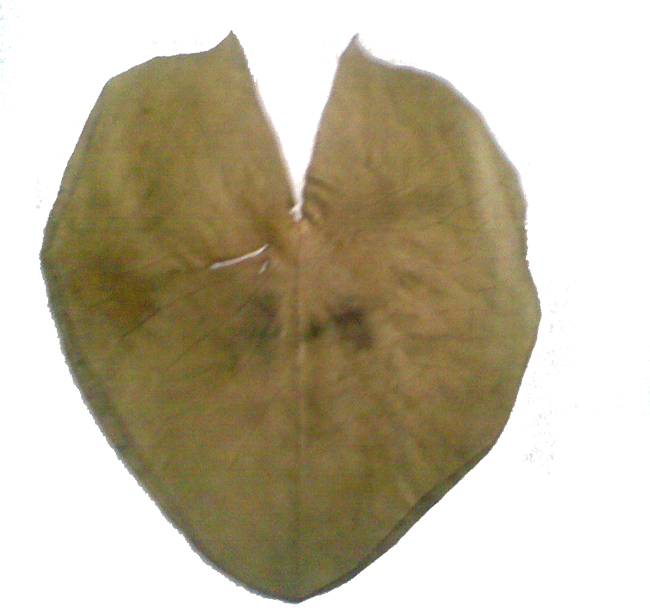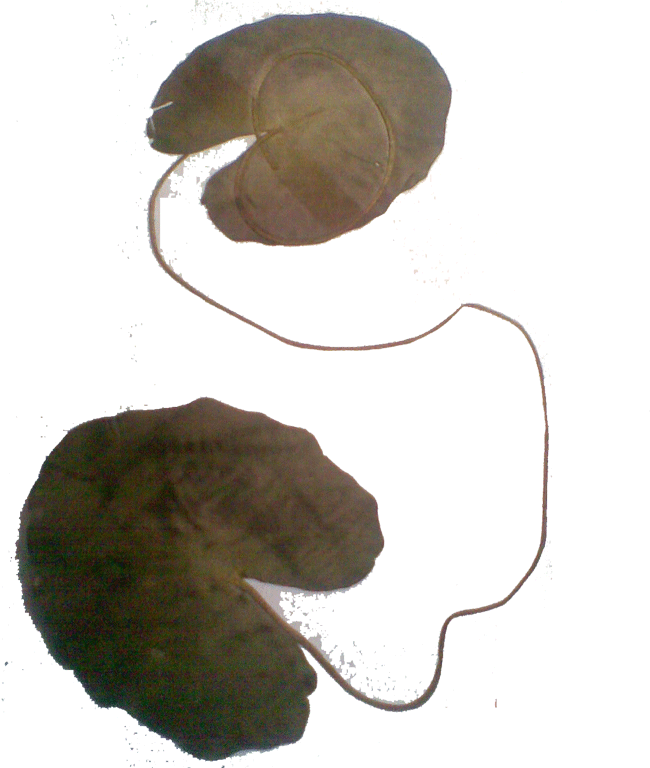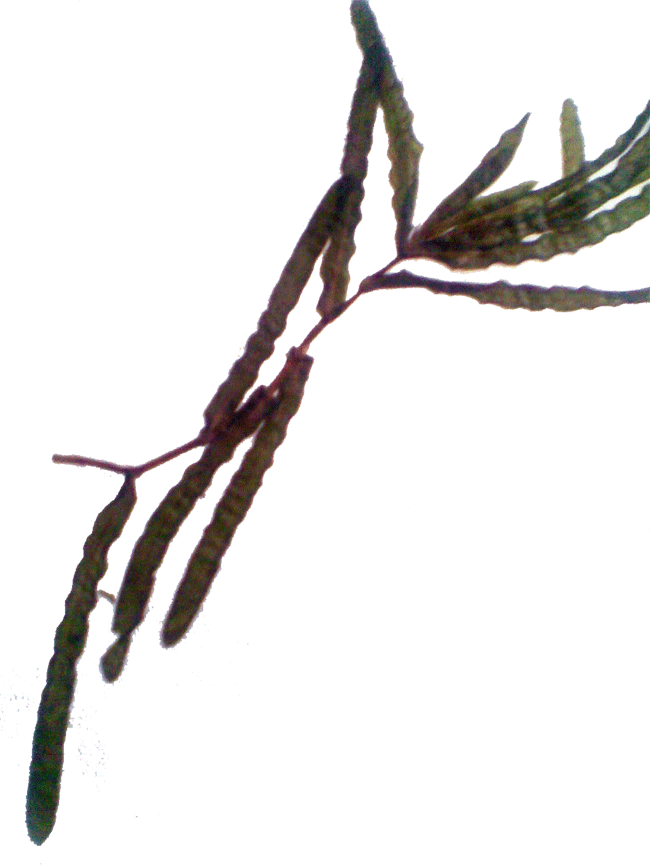|


2010, Vol. 5 No. 1, Article 53
A Study on Nutritional Potential
of Aquatic Plants
K. A. Shah*, Syed Sumbul and Syed Anjum Andrabi
Department of Animal Husbandry (Kashmir), Srinagar
*Corresponding Author;
e-mail address: [email protected]
ABSTRACT
A study was conducted to evaluate nutritional potential of three local aquatic plants, Nymphaea alba-water lilly (Bum), Nymphoides peltata (khor) and Hydrilla species (Khel) which grow abundantly in
the Dal and other lakes and water bodies of Kashmir. Proximate analysis revealed that
all the three plants had dry matter below 10%. Crude protein content of Hydrilla, Nymphaea and Nymphoides was 17.10%, 20.28% and 21.87% respectively. Ether extract level of
Hydrilla (2.79%), Nymphaea (1.5%) and Nymphoides (3.5%) was also estimated. Ash content varied from 8% in Nymphaea to 19.45% in Hydrilla. Calcium content was 1.29%, 1.10% and 1.56% in Hydrilla, Nymphae and Nymphoides respectively.
Fiber content was lowest (13.34%) in Hydrilla and highest (21%) in Nymphoides. Animals fed with aquatic plants (Group A) produced about 3
liters more milk per day per animal than straw fed (Group C) animals.There was however no
significant difference in daily milk yield of Group A and Berseem fed (group B) animals .
KEY
WORDS
Aquatic plants, animal feeding, milk yield.
INTRODUCTION
Aquatic plants grow profusely in lakes and waterways all over the world and have become weedy in many lakes and ponds in India as well (Gupta, 2001). These may be categorized as floating submerged and emergent aquatic plants. For centuries, aquatic plants have been perceived as
a nuisance rather than resource. They block canals, hinder boat traffic and increase water borne diseases. In
the recent past numerous workers all over the globe have tried to explore the possibilities of using these plants as a source of animal feed (Anon ,1984) (Benergy and Matai, 1990) and as medicinal plants (Nandkarni, 1992), (Nagma and Sarwat, 2005) (Deepa et. al. 2009). In Jammu &
Kashmir numerous aquatic plants like Nymphoides, Rannunculus, Nymphaea, Hydrilla, Azolla, Nelumbo, Trapa
etc. species are found in different lakes and water bodies (Bhat, 2002 ) which deplete their water quality and reduce their area. Owing to acute shortage of fodder in the valley, utilization of these plants as animal feed could be considered after evaluating their nutritional potential. Aquatic weeds are known to differ widely in their chemical composition depending upon species, season and location (Anon, 1984).
The present study was undertaken with an objective
of carrying out the proximate analysis of three aquatic plants Nymphaea alba
- water lilly (Bum), Nymphoides peltata (khor) and Hydrilla species (Khel) and
recording effect of feeding these plants on milk yield of cattle under field conditions.
Nymphaea alba (Fig 1) is an aquatic, floating perennial herb occurring in lakes, ponds, ditches and similar water bodies in parts of valley
below 5200 ft. sea level. Nymphaea alba is a well known and potent chemo preventive agent and suppresses Fe-NTA-induced oxidative stress, hyper proliferative response and renal carcinogenesis in Wistar rats (Naghma Khan and Sarwat Sultana, 2005). Nymphoides (Fig 2) is also
a floating aquatic plant found in lakes and ponds of the valley and Hydrilla (Fig-3) is
a submerged type of aquatic plant occurring in ponds lakes and ditches.
MATERIALS AND METHODS
The plants were harvested in a lush green condition from different lakes of the valley to form eight replicate samples of each plant. The harvested
samples were placed in polyethylene bags and transported to the laboratory where they were cut to include only leaves and petioles. These were then washed thoroughly
and drained before being weighed and dried in an oven at 100°C to
constant weight for dry matter determinations. Samples were ground
in a mill and stored until analyses could be conducted for proximate
components and calcium (AOAC, 1995).
To evaluate the effect of
feeding these plants on milk production, a field trial was conducted
on sixty cross bred cows of variable age and lactation in certain pockets of Srinagar where farmers
were previously feeding aquatic plants adlib to cattle and claiming
higher milk yields. The animals were randomly allotted to three groups, A, B & C with twenty animals in each group. Animals of Group A were fed with 10 kgs of the aquatic plants (all the three plants in equal quantity), 6 Kgs of concentrate and were also allowed 4-6 hours of grazing daily for 45 days.
The same feeding schedule (Table 1) was adopted for animals of the other two groups but aquatic plants were replaced by green fodder (Berseem) in group B and by Paddy straw in Group C
(control). The total quantity of feed was almost constant for all animals. The observations were based on the field trial hence all the treatments were carried out in the field animals randomly without selection but recorded properly.
RESULTS
The results regarding proximate components and calcium are indicated at (Table 2). Animals fed with aquatic plants (Group A) produced about 3
litres more milk per day per animal than straw fed (Group C) animals. There was however no major difference in daily milk yield of Group A and group B animals (Table3).
DISCUSSION
All the three plants had dry matter below 10% which lies in agreement with reports of Boyd (1968). Crude protein content of
Hydrilla, Nymphaea and Nymphoides was 17.10%, 20.28% and 21.87% respectively which is comparable with findings of Polisini and Boyd (1972), the
lower values observed in Hydrilla which is a submerged plant, may be due to environmental differences as nutrient concentration in the aquatic environment are known to affect crude protein contents of aquatic plants Hutchinson(1975). Ether extract level of
Hydrilla (2.79%), Nymphaea (1.5) and Nymphoides (3.5%) falls within the range (1.18% - 5.42%) reported in aquatic plants by Boyd (1968). Ash content varied from 8% in
Nymphaea to 19.45% in Hydrilla. Calcium content was 1.29, 1.10 and 1.56% in
Hydrilla, Nymphae and Nymphoides respectively.
Fiber content was lowest (13.34%) in Hydrilla and highest(21%) in
Nymphoides. All these values fall in close agreement with the findings of Banerjee and Matai (1990).
The higher
fiber content in Nymphaea and Nymphoides may be due to the fact that floating plants require more strength to support aerial vegetation. Nitrogen free extract ranged from 43.92% in Hydrilla to 62.22% in Nymphaea. These values are higher than those reported by Banerjee and Matai(1990). Among the three aquatic plants
Nymphaea and Nymphoides were highly palatable and had almost negligible refusal where as in case of
Hydrilla refusal was about 60-70%.
Nymphaea alba has medicinal properties and perusal of literature reveals that all these plants contain traces of alkaloids and polyphenols
but within a range (Banerjee and Matai, 1990 and Bondi and Alumot, 1987) which will not produce any harmful effect to the animals
Nymphaea and Nymphoides contain crude protein (above 20%) which is higher than that of berseem hay (15-17%) and other conventionally used livestock feeds (Reddy 2001), calcium (1-1.5%) which is higher than that of all pasture grasses (0.1%)
and all cereal grains (0.06-0.31%) (Lander 2001). The NFE, a non specific source of energy (50-62%)
was higher than that of berseem hay (41%) and maize (51%) (Banerjee, 1980). The increase in milk yield of the animals fed with aquatic plants may be attributed to the higher nutrient content of these plants.
Additionally, both Nymphae and Nymphoides had high palatability
and palatable feeding stuffs are easily digested and tend to promote digestibility of the whole ration (Lander 2001).
Thus these plants could used as a potential substitute for forages consumed by ruminants to over come fodder scarcity in the state. The nutrient content and palatability of
Hydrilla was comparatively low with 60-70% refusal. Vast study with diversified parameters needs to be carried out on mineral content, digestibility,
palatability and safety aspect of these plants.
ACKNOWLEDGEMENT
The authors are highly indebted to Poultry
Nutritionist
and Assistant Poultry Nutritionist, Department of Animal Husbandry for their
valuable support.
REFERENCES
-
Anon. 1984. Making aquatic weeds useful : some perspectives for developing countries. National Academy of Sciences, Washington, D.C., 175.
-
AOAC, 1995. Official methods of analysis (14th ed.) Association of Official Analytic Chemistry, Washington
-
Banerjee, A. and Matai. S. 1990. Composition of Indian aquatic plants in relation to utilization as Animal Forage: J . Aquat. Plant Manage. 28: , 69-73
-
Banerjee, G. C. 1988: Feeds and
Principles of Animal Nutrition (2nd Ed.) Oxford and IBH Pub. Co. Delhi P630-40
-
Bhat, N.A. 2002: Some Common Wild Flowers of Srinagar. Makoff printers Delhi
-
Bondi, A and Alumot, E. 1987: Anti nutritive factors in Animal feed stuffs and their effects on live stock. Progress in Food and Nutrition Science (11) ; 115-151
-
Boyd, C.E. 1968 Fresh water plants: a potential source of protein. Economic Botony 22: 359-368.
-
Christine Pollock from: http://www.ehow.com/facts_5649884_aquatic-plants-used-cattle-feed.html
-
Deepa, M Usha, P.T.A., Nair.,CP Prasanna
Kumar: 2009. Antipyretic activity of seeds from Nelumbo nucifera in Albino rat:
Veterinary World Vol. 2(6) 213-14
-
Gupta, O.P.1987. In: Aquatic Weed management, I V F .Pub. Co. Ltd. New Delhi
-
Hutchinson, G. 1975 Limnological Botany ,New York p 260-395
-
Lander, P. 2001 The Feeding of Farm Animals in India, Biotech Books Delhi p-303-312
-
Naghma Khan and Sarwat Sultana. 2005. Anticarcinogenic effect of
Nymphaea alba against oxidative damage, hyperproliferative response and renal carcinogenesis in Wistar rats. Molecular and Cellular Biochemistry, 271: 1-11.
-
Nandkarni, A.K. 1992: Nandkarni’s Indian Meteria Medica , Vol.1 p-845
-
Polisini M. and Boyd, C. 1972: Relation between cell wall fraction, nitrogen and standing crop in aquatic macrophytes. Ecology. (53) 483-90
-
Reddy, D.V. 2001 Principles of Animal Nutrition and Feed Technology Oxford and IVH Pub. Co. Delhi
Table-1 Schedule of feeding
|
Feeding hours
|
Group A
|
Group B
|
Group C
|
|
Morning
(4-6hrs.)
|
Grazing
|
Grazing
|
Grazing
|
|
14:00h
|
Aquatic plants -10kgs
|
Green fodder-10kgs
|
Paddy straw-10kgs
|
|
20:00h
|
Concentrate-6kgs
|
Concentrate-6kgs
|
Concentrate-6kgs
|
Table
2: Chemical composition of aquatic plants (% DM)
|
Constituents
|
Hydrilla
|
Nymphaea
|
Nymphoides
|
|
Organic Matter
|
80.44
|
88.40
|
88.40
|
|
Crude Protein
|
17.10
|
21.87
|
21.87
|
|
Ether Extract
|
2.79
|
3.50
|
3.50
|
|
Total Ash
|
19.45
|
11.6
|
11.60
|
|
Crude Fiber
|
13.34
|
21.00
|
21.00
|
|
Nitrogen Free
Extract
|
43.92
|
49.03
|
49.03
|
|
Calcium
|
1.29
|
1.56
|
1.56
|
|
Dry matter
|
6.12
|
8.12
|
7.72
|
Table3: Daily average milk yield of cows under different feeding
schedules
|
Group
|
Daily milk yield(Litre)
|
|
A
|
16.12
|
|
B
|
15.89
|
|
C
|
13.2
|
Fig 1: Nymphaea alba

Fig 2: Nymphoides peltata

Fig 3: Hydrilla spp.

|
 |





